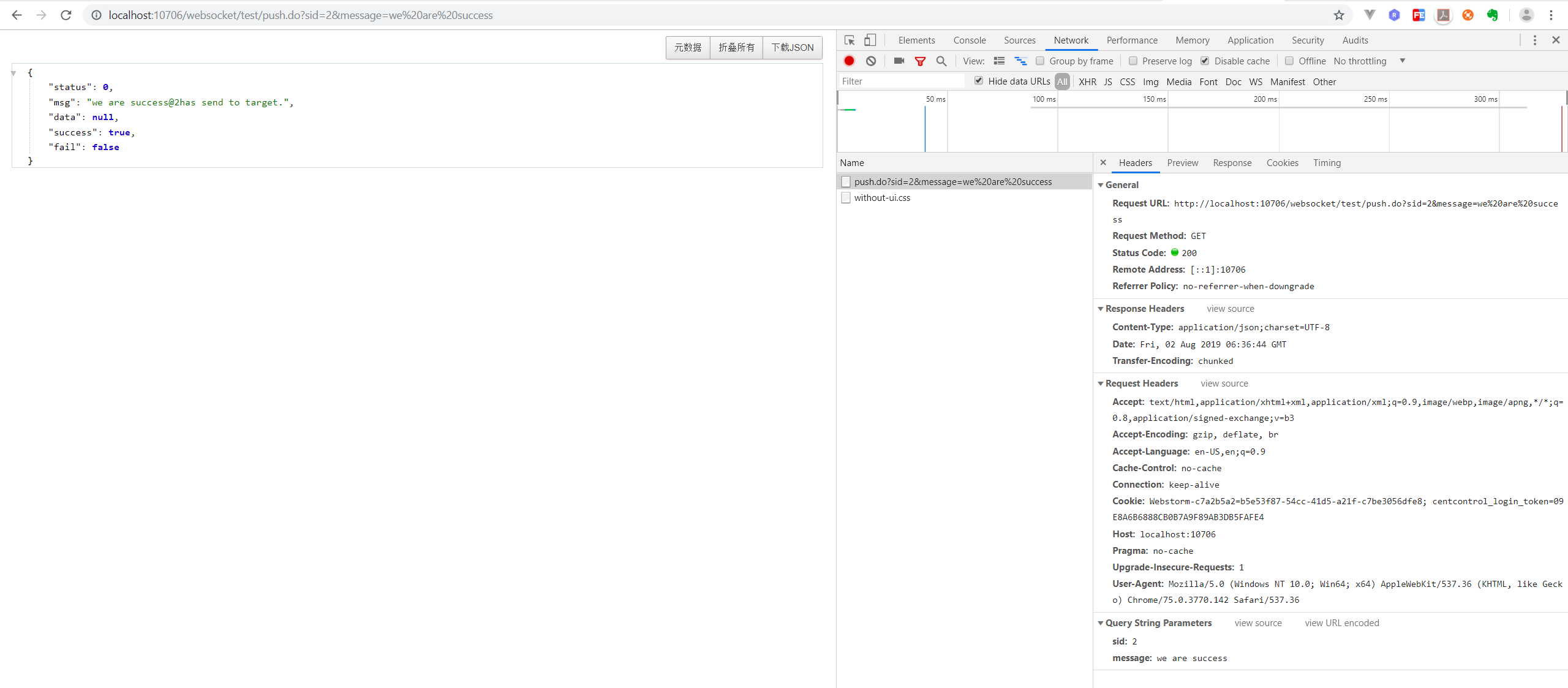WebSocket的實現與應用
- 2019 年 10 月 3 日
- 筆記
WebSocket的實現與應用
前言
說到websocket,就不得不提http協議的連接特點特點與交互模型。
首先,http協議的特點是無狀態連接。即http的前一次連接與後一次連接是相互獨立的。
其次,http的交互模型是請求/應答模型。即交互是通過C/B端向S端發送一個請求,S端根據請求,返回一個響應。
那麼這裡就有一個問題了–S端無法主動向C/B端發送消息。而交互是雙方的事情,怎麼能限定一方發數據,另一方接數據呢。
傳統解決方案:
傳統的解決方案就倆字:輪詢。
長短連接輪詢就不詳細說了,就說說輪詢。大概的場景是這樣的:
客戶端(Request):有消息不?
服務端(Response):No
客戶端(Request):有消息不?
服務端(Response):No
客戶端(Request):有消息不?
服務端(Response):No
客戶端(Request):有消息不?
服務端(Response):有了。你媽叫你回家吃飯。
客戶端(Request):有消息不?
服務端(Response):No
==================================> loop
看著都累,資源消耗那就更不必說了。尤其有些對實時性要求高的數據,那可能就是1s請求一次。目測伺服器已經淚奔。
websocket解決方案:
那麼websocket的解決方案,總結一下,就是:建立固定連接
說白了,就是C/B端與S端就一個websocket服務建立一個固定的連接,不斷開。
大概的場景是這樣的:
服務端:我建立了一個chat的websocket,歡迎大家連接。
客戶端:我要和你的chat的websocket連接,我的sid(唯一標識)是No.1
服務端:好的,我已經記住你了。如果有發往chat下No.1的消息,我會告訴你的。
客戶端:嗯。謝謝了哈。
==================================> 過了一段時間
(有一個請求調用了chat的websocket,並且指名是給No.1的消息)
服務端(發送消息給No.1):No.1,有你的消息。你媽媽叫你回家做作業。
客戶端(No.1):好的。我收到了。謝謝。
由於這次只是簡單說一下websocket,所以就不深入解讀網路相關知識了。
應用場景
既然http無法滿足用戶的所有需求,那麼為之誕生的websocket必然有其諸多應用場景。如:
- 實時顯示網站在線人數
- 賬戶餘額等數據的實時更新
- 多玩家網路遊戲
- 多媒體聊天,如聊天室
- 。。。
其實總結一下,websocket的應用場景就倆字:實時
無論是多玩家網路遊戲,網站在線人數等都是由於實時性的需求,才用上了websocket(後面用縮寫ws)。
談幾個在我項目中用到的情景:
- 在線教育項目中的課件系統,通過ws實現學生端課件與教師端課件的實時交互
- 物聯網項目中的報警系統,通過ws實現報警資訊的實時推送
- 大數據項目中的數據展示,通過ws實現數據的實時更新
- 物聯網項目中的硬體交互系統,通過ws實現硬體非同步響應的展示
當你的項目中存在需要S端向C/B端發送數據的情形,那就可以考慮上一個websocket了。
實現
服務端開發:
引入依賴:
<!-- websocket --> <dependency> <groupId>org.springframework.boot</groupId> <artifactId>spring-boot-starter-websocket</artifactId> </dependency> 添加配置:
忍不住想要吐槽,為什麼不可以如eureka等組件那樣,直接在啟動類寫一個註解就Ok了呢。看來還得以後自己動手,豐衣足食啊。
package com.renewable.center.warning.configuration; import org.springframework.context.annotation.Bean; import org.springframework.context.annotation.Configuration; import org.springframework.web.socket.server.standard.ServerEndpointExporter; /** * Websocket的配置 * 說白了就是引入Websocekt至spring容器 */ @Configuration public class WebSocketConfig { @Bean public ServerEndpointExporter serverEndpointExporter() { return new ServerEndpointExporter(); } } 程式碼實現:
WebSocketServer的實現:
package com.renewable.center.warning.controller.websocket; import lombok.extern.slf4j.Slf4j; import org.apache.commons.lang3.StringUtils; import org.springframework.stereotype.Component; import javax.websocket.*; import javax.websocket.server.PathParam; import javax.websocket.server.ServerEndpoint; import java.io.IOException; import java.util.concurrent.CopyOnWriteArraySet; /** * @Description: * @Author: jarry */ @Component @Slf4j @ServerEndpoint("/websocket/warning/{sid}") public class WarningWebSocketServer { // JUC包的執行緒安全Set,用來存放每個客戶端對應的WarningWebSocketServer對象。 // 用ConcurrentHashMap也是可以的。說白了就是類似執行緒池中的BlockingQueue那樣作為一個容器 private static CopyOnWriteArraySet<WarningWebSocketServer> warningWebSocketSet = new CopyOnWriteArraySet<WarningWebSocketServer>(); // 與某個客戶端的連接會話,需要通過它來給客戶端發送數據 private Session session; // 接收sid private String sid=""; /** * 建立websocket連接 * 看起來很像JSONP的回調,因為前端那裡是Socket.onOpne() * @param session * @param sid */ @OnOpen public void onOpen(Session session, @PathParam("sid") String sid){ this.session = session; this.sid = sid; warningWebSocketSet.add(this); sendMessage("websocket connection has created."); } /** * 關閉websocket連接 */ @OnClose public void onClose(){ warningWebSocketSet.remove(this); log.info("there is an wsConnect has close ."); } /** * websocket連接出現問題時的處理 */ @OnError public void onError(Session session, Throwable error){ log.error("there is an error has happen ! error:{}",error); } /** * websocket的server端用於接收消息的(目測是用於接收前端通過Socket.onMessage發送的消息) * @param message */ @OnMessage public void onMessage(String message){ log.info("webSocketServer has received a message:{} from {}", message, this.sid); // 調用消息處理方法(此時針對的WarningWebSocektServer對象,只是一個實例。這裡進行消息的單發) // 目前這裡還沒有處理邏輯。故為了便於前端調試,這裡直接返回消息 this.sendMessage(message); } /** * 伺服器主動推送消息的方法 */ public void sendMessage(String message){ try { this.session.getBasicRemote().sendText(message); } catch (IOException e) { log.warn("there is an IOException:{}!",e.toString()); } } public static void sendInfo(String sid, String message){ for (WarningWebSocketServer warningWebSocketServerItem : warningWebSocketSet) { if (StringUtils.isBlank(sid)){ // 如果sid為空,即群發消息 warningWebSocketServerItem.sendMessage(message); log.info("Mass messaging. the message({}) has sended to sid:{}.", message,warningWebSocketServerItem.sid); } if (StringUtils.isNotBlank(sid)){ if (warningWebSocketServerItem.sid.equals(sid)){ warningWebSocketServerItem.sendMessage(message); log.info("single messaging. message({}) has sended to sid:{}.", message, warningWebSocketServerItem.sid); } } } } } WesocketController
為了便於調試與展示效果,寫一個控制層,用於推送消息
package com.renewable.center.warning.controller.websocket; import com.renewable.terminal.terminal.common.ServerResponse; import org.springframework.stereotype.Controller; import org.springframework.web.bind.annotation.GetMapping; import org.springframework.web.bind.annotation.RequestMapping; import org.springframework.web.bind.annotation.RequestParam; import org.springframework.web.bind.annotation.ResponseBody; import java.io.IOException; /** * @Description: 用於測試WebsocketServer * @Author: jarry */ @Controller @RequestMapping("/websocket/test/") public class WarningWebsocketController { @GetMapping("link.do") @ResponseBody public ServerResponse link(@RequestParam(name = "sid") int sid){ return ServerResponse.createBySuccessMessage("link : "+sid); } /** * 調用WarningWebsocketServer的消息推送方法,從而進行消息推送 * @param sid 連接WarningWebsocketServer的前端的唯一標識。如果sid為空,即表示向所有連接WarningWebsocketServer的前端發送相關消息 * @param message 需要發送的內容主體 * @return */ @ResponseBody @RequestMapping("push.do") public ServerResponse pushToWeb(@RequestParam(name = "sid", defaultValue = "") String sid, @RequestParam(name = "message") String message) { WarningWebSocketServer.sendInfo(sid, message); return ServerResponse.createBySuccessMessage(message+"@"+sid+" has send to target."); } } WesocketTestIndex
這裡建立了一個B端頁面,用於與S端進行交互,演示。
<!DOCTYPE html> <html lang="en"> <head> <meta charset="UTF-8"> <title>WebsocketTestIndex</title> </head> <body> <h1>Websocket Test</h1> <script> var socket; if(typeof(WebSocket) == "undefined") { console.log("Your browser not support WebSocket !"); }else{ console.log("Your browser support WebSocket"); // 實例化WebSocket對象 // 指定要連接的伺服器地址與埠 // 建立連接 socket = new WebSocket("ws://localhost:10706/websocket/warning/2"); // 打開事件 socket.onopen = function() { console.log("You has connect to WebSocketServer"); }; // 獲得消息事件 socket.onmessage = function(msg) { // 列印接收到的消息 console.log(msg.data); }; // 關閉事件 socket.onclose = function() { console.log("Socket has closed"); }; // 發生了錯誤事件 socket.onerror = function() { alert("Socket happen an error !"); } } </script> </body> </html> 效果展示
再次強調,圖片很大很清晰。如果看不清楚,請單獨打開圖片。
B端網頁初始化:

調用S端WarningWebsocketController下pushToWeb()介面,對sid=2的B端發送消息:

B端網頁接收到專門發給sid=2的消息後的效果:

調用S端WarningWebsocketController下pushToWeb()介面,所有連接該websocket的B端群發消息:

B端網頁接收到群發消息後的效果:

S端接收到消息後的日誌列印:

S端在B端關閉連接後的日誌列印:

總結
至此,websocket的應用就算入門了。至於實際的使用,其實就是服務端自己調用WebSocket的sendInfo介面。當然也可以自己擴展更為細緻的邏輯,方法等。
另外,需要注意的是,別忘了及時關閉webocket的連接。尤其在負載較大的情況下,更需要注意即使關閉不必要的連接。
架構的技術選型,需要的不是最好的,而是最適合的。
擴展:
如果想要了解更多概念上的細節,可以看看這篇文章:
